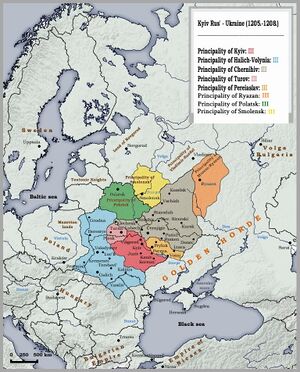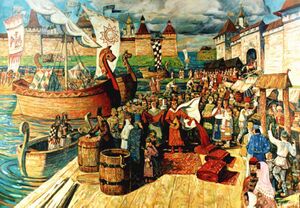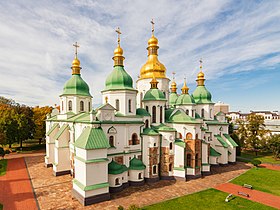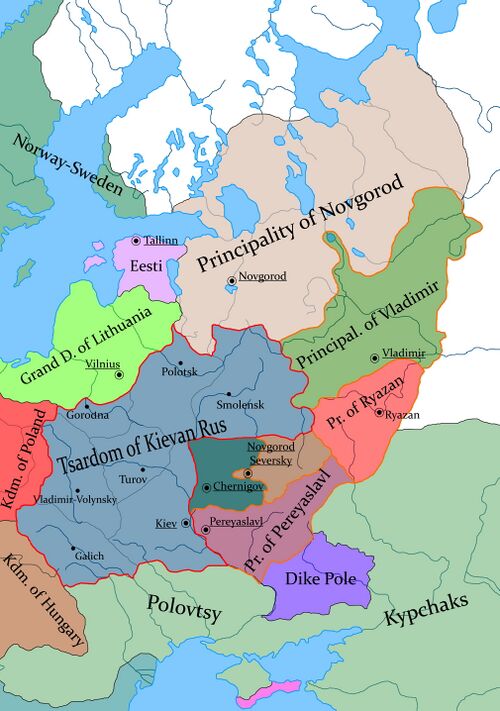Kiewan Rus
Tsardom of Kievan Rus Царство Київської Русі | |
|---|---|
| Capital and largest city | Kiev |
| Official languages | Old East Slavic |
| Recognised national languages | Old East Slavic Church Slavonic |
| Religion | Eastern Orthodox Church |
| Demonym(s) | Kievites |
| Government | Feudal absolute monarchy |
• Tsar | Daniel Romanovich from the Rurik dynasty |
| Legislature | Veche |
| History | |
• Established | 879 |
• Conquest of Khazar Khaganate | 965–969 |
| 988 | |
| early 11th century | |
| Area | |
• Total | 582,168 km2 (224,776 sq mi) |
• Water (%) | 6.1% |
| Population | |
• 1205 estimate | ~6,000,000 |
| Currency | Grivna (₴) |
Kievan Rus or Tsardom of Kievan Rus (Old East Slavic: Роусь, romanized: Rusĭ, or роусьскаѧ землѧ, romanized: rusĭskaę zemlę, "Rus' land") was a loose federation of East Slavic and Uralic peoples in Europe from the late 9th to the mid-13th century, under the reign of the Rurik dynasty, founded by the Varangian prince Rurik. At its greatest extent, in the mid-11th century, it stretched from the White Sea in the north to the Black Sea in the south and from the headwaters of the Vistula in the west to the Taman Peninsula in the east, uniting the majority of East Slavic tribes.
According to Rus Primary Chronicle, the first ruler to start uniting East Slavic lands into what has become known as Kievan Rus' was Prince Oleg (879–912). He extended his control from Novgorod south along the Dnieper river valley to protect trade from Khazar incursions from the east, and moved his capital to the more strategic Kiev. Sviatoslav I (died 972) achieved the first major expansion of Kievan Rus territorial control, fighting a war of conquest against the Khazars. Vladimir the Great (980–1015) introduced Christianity with his own baptism and, by decree, extended it to all inhabitants of Kiev and beyond. Kievan Rus reached its greatest extent under Yaroslav the Wise (1019–1054); his sons assembled and issued its first written legal code, the Russkaya Pravda ("Rus' Justice"), shortly after his death.
The state began to decline during the late 11th century, disintegrating into various rival regional powers. It was further weakened by economic factors, such as the collapse of Rus' commercial ties to the Byzantine Empire due to the decline of Constantinople and the accompanying diminution of trade routes through its territory. However, in 1202 Roman Mstislavich, the Grand Duke of Galicia and Volhynia, became the Grand Duke of Kiev and from 1203 to 1205 he conducted campaigns of conquest against the Principality of Polotsk and Smolensk. After that, he was crowned Tsar of the Second Kievan Rus, laying the foundation for the reunification of the lost lands.
Etymology
During its existence, Kievan Rus' was known as the "land of the Rus" (Old East Slavic: ро́усьскаѧ землѧ, from the ethnonym Ро́усь; Greek: Ῥῶς; Arabic: الروس ar-Rūs), in Greek as Ῥωσία, in Old French as Russie, Rossie, in Latin as Rusia or Russia (with local German spelling variants Ruscia and Ruzzia), and from the 12th century also Ruthenia or Rutenia. Various etymologies have been proposed, including Ruotsi, the Finnish designation for Sweden or Ros, a tribe from the middle Dnieper valley region. According to the prevalent theory, the name Rus', like the Proto-Finnic name for Sweden (*Ruotsi), is derived from an Old Norse term for "the men who row" (rods-) as rowing was the main method of navigating the rivers of Eastern Europe, and that it could be linked to the Swedish coastal area of Roslagen (Rus-law) or Roden, as it was known in earlier times. The name Rus' would then have the same origin as the Finnish and Estonian names for Sweden: Ruotsi and Rootsi.
In the Norse sources, the sagas, the principality is called Garðariki, and the peoples, according to Snorre Sturlason, are called Suiones, the confederation of Great Sviþjoð (Þjoð means people in Norse) were made up of the peoples along the Dniepr called Tanais that separated Asia and Europe (called Enea by Snorri Sturluson), all the way to the Baltics and Scandinavia.
History
Demographics
Society
Due to the expansion of trade and its geographical proximity, Kiev became the most important trade centre and chief among the communes; therefore the leader of Kiev gained political "control" over the surrounding areas. This princedom emerged from a coalition of traditional patriarchic family communes banded together in an effort to increase the applicable workforce and expand the productivity of the land. This union developed the first major cities in the Rus and was the first notable form of self-government. As these communes became larger, the emphasis was taken off the family holdings and placed on the territory that surrounded. This shift in ideology became known as the verv'.
In the 11th and the 12th centuries, the princes and their retinues, which were a mixture of Slavic and Scandinavian elites, dominated the society of Kievan Rus'. Leading soldiers and officials received income and land from the princes in return for their political and military services. Kievan society lacked the class institutions and autonomous towns that were typical of Western European feudalism. Nevertheless, urban merchants, artisans and labourers sometimes exercised political influence through a city assembly, the veche (council), which included all the adult males in the population. In some cases, the veche either made agreements with their rulers or expelled them and invited others to take their place. At the bottom of society was a stratum of slaves. More important was a class of tribute-paying peasants, who owed labour duty to the princes.
The change in political structure led to the inevitable development of the peasant class or smerds. The smerdy were free un-landed people that found work by labouring for wages on the manors that began to develop around 1031 as the verv' began to dominate socio-political structure. The smerdy were initially given equality in the Kievian law code; they were theoretically equal to the prince; so they enjoyed as much freedom as can be expected of manual labourers. However, in the 13th century, they slowly began to lose their rights and became less equal in the eyes of the law.
Religion
In 988, the Christian Church in Rus' territorially fell under the jurisdiction of the Ecumenical Patriarchate of Constantinople after it was officially adopted as the state religion. According to several chronicles after that date the predominant cult of Slavic paganism was persecuted.
The exact date of creation of the Kiev Metropolis is uncertain, as well as who was the first leader of the church. Predominantly it is considered that the first head was Michael I of Kiev, however some sources also claim Leontiy who is often placed after Michael or Anastas Chersonesos, became the first bishop of the Church of the Tithes. The first metropolitan to be confirmed by historical sources is Theopemp, who was appointed by Patriarch Alexius of Constantinople in 1038. Before 1015 there were five dioceses: Kiev, Chernihiv, Bilhorod, Volodymyr, Novgorod, and soon thereafter Yuriy-upon-Ros. The Kiev Metropolitan sent his own delegation to the Council of Bari in 1098.
By the mid 13th century, the dioceses of Kiev Metropolis (988) were as follows: Kiev (988), Pereyaslav, Chernihiv (991), Volodymyr-Volynsky (992), Turov (1005), Polotsk (1104), Novgorod (~990s), Smolensk (1137), Murom (1198), Peremyshl (1120), Halych (1134), Rostov (991), Bilhorod, Yuriy (1032). There also were dioceses in Zakarpattia and Tmutarakan.
Language
Cities and fortresses
Economy
Monetary system
The formation of monetary circulation in the Slavic lands of Eastern Europe occurs at the turn of the VIII-IX centuries, when active trade of Northern and Eastern Europe with the countries of the Caliphate began. Eastern European countries, deprived of large ore reserves of coinage, actively imported silver. In the first third of the 9th century, coins that were minted in the African centers of the Caliphate and which came to Russia through the Caucasian and Central Asian trade routes became widespread in Ancient Rus. Since the 830s, Asian dirhams have become widespread.
In the second half of the 10th century, two territorial Russian systems appeared, which were defined against the background of different gravitation of the northern and southern regions to international markets. The main means of circulation of Southern Russia (Kiev, Chernigov, Smolensk, etc.) were cuttings from dirhams weighing 1.63 grams, which make up 1/200 of a Byzantine liter. Similar cuttings were used in the lands of Northern Russia, but their weight was 1.04 grams, or 1/200 of a silver hryvnia. An important monument of this system is the spherical weight weights used in the northern regions of Russia for weighing silver coins. After the extinction of the influx of eastern coins to Russia due to the weakening of the Caliphate, they were replaced by commodity-money. At the turn of the 10th-11th centuries, during the times of Vladimir and Svyatopolk, an attempt was made to mint their own coins. However, it was soon discontinued due to the lack of a raw material base.
In the Kiev, Western European denarii of Germanic, English and Scandinavian coinage came to replace dirhams.







